By the late 1970s, the old Tartan 34 had become very dated. The boat had been in production for a decade, and hundreds of families had cut their racing and cruising teeth on the S&S keel/centerboarder. But the market was changing. Boats were faster and lighter, keels and rigs more efficient, interiors roomier and more functional.
Tartan 33 Specs
In 1978, Tartan brought out the Tartan Ten, a 33-foot, fairly light, fractionally-rigged “offshore one design.” The boat was a huge success: fast, easy to sail, and unencumbered by the design limitations of a rating rule.
But the Tartan Ten had one big problem: limited accommodations with stooping headroom, an interior most kindly described as spartan. A hardy crew could take the Tartan Ten on a multi-day race such as the Mackinac, and you might even coax your family aboard for a weekend of camping out. But cruising or extended racing in comfort? Forget it!
If, however, you could combine the size and performance of the Tartan Ten with a boat having decent accommodations, you had a good shot at a winning combination, particularly in a time when interest in sailing was growing at an astounding rate. As a bonus, the venerable Tartan 34 could be retired with the dignity she deserved.
The answer to all these prayers was the Tartan 33. Introduced as a 1979 model, the Tartan 33 bore a strong resemblance to the Tartan Ten, with a big fractional rig, flattish sheer, and wide stern. But unlike the Tartan Ten, the new 33 had good accommodations.
The Tartan 33 was a moderate success, with about 220 boats built over a five-year period. The fractional rig, touted as being easier to handle due to smaller headsails, may have turned off some customers who associated that type of rig with high performance boats such as J/24s and 12 meters. The slotted aluminum toe-rail of the 33 was more reminiscent of Tartan’s racing boats, such as the 41 and the Ten, than it was of a high-quality cruiser/racer.
In 1984, the Tartan 33 went out of production. In its place came the “new” Tartan 34, a boat that could directly cash in on the reputation of the famous old Tartan 34. Interestingly, the new Tartan 34 is the Tartan 33, with the stern drawn out 9 inches to a more pleasing termination, the interior redesigned to meet market demands, and the 33’s fractional rig replaced by the masthead rig of the Tartan 33R.
Compared to the Tartan 33, the new 34 is more finely finished, with teak toerails and nicer interior detailing.
When first introduced, the Tartan 33 had a base price of just over $46,000. By the time production ceased, the base price had increased to $66,000. Remember, those were the years of double-digit inflation.
Sailing Performance
As originally configured—Scheel keel and fractional rig—performance of the Tartan 33 might be a little disappointing for someone coming from a Tartan Ten, but is certainly on a par with most other boats of the same size, type, and vintage. In absolute terms the Tartan 33 is spritely, but not stunning, with a PHRF rating of about 160. By comparison, the old C&C 34—a good all-around cruiser/racer from the same period—rates 144, 16 seconds per mile faster. The C&C 34 and Tartan 33 are almost identical in length, sail area, and displacement.
In lighter winds, the fractionally-rigged Tartan 33 is at its biggest disadvantage, particularly off the wind. The big mainsail allows you to sail fairly low, but you go pretty slow. By comparison, a boat with a big masthead spinnaker will be sailing a little higher and quite a bit faster for optimum off-wind VMG in the same conditions.
The Tartan 33’s interior departs from the norms for cruising boats in this area. Most owners who have lived with the interior for some time find it quite workable, but the boat’s successor, the T-34, better addresses the cruising sailor’s accommodation needs.
- Bifold doors separate main cabin from the head, which extends across the width of the boat, just aft of the v-berth. The drop-down table dines four comfortably. A short settee—less than 5-feet long—with the icebox occupying a high counter at what would normally be the head of the berth.
- The L-shaped galley is serviceable but counter space is at a premium.
- A quarterberth offers snug cubby for guests, but its usual function is a mini-garage.
- The navigator sits in a snug cutout, so it’s a bit of a stretch to reach the electrical panel outboard. Laptop navigation is unimpeded.
- Owners praise the joinery on the Tartan. There are no veneer laminates, only finely joined solid wood. There is more storage than one would expect in a boat of this size.
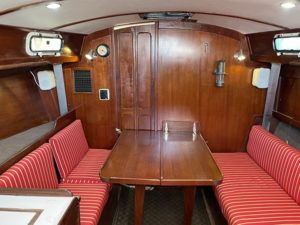

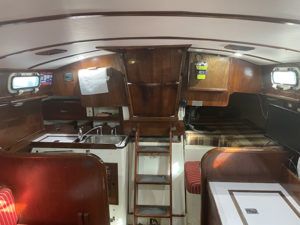
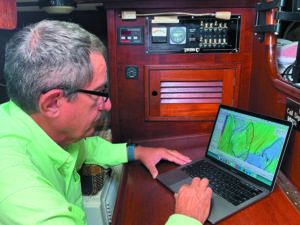


IMS (International Measurement System) velocity predictions show that the Scheel keel Tartan 33 must in general be sailed a little lower and flatter than a comparable fin keel boat, although the 33’s righting moment is very similar to that of a fin keel boat of the same size and type, as is her range of positive stability.
The Tartan 33 was not designed to any rating rule, but a number have been rated under the IMS. In some areas, there are enough of the boats to allow them to sail together as a one-design class, but the boat is not fast enough in absolute terms to stir the blood of most sailors interested in one-design racing. In addition, Tartan 33 sailors disagree on the proper amount of headsail overlap for the boat, making level racing more difficult.
To offset the rather average performance of the Tartan 33, the 33R was introduced in 1982. The 33—“R” for “Racing”—has a deep fin keel and a double-spreader masthead rig. The difference in performance between the 33 and the 33R is pretty amazing: the 33R is almost 30 seconds per mile faster than the stock 33, even though the sail area is almost identical.
Righting moment of the fin keel and Scheel keel boats is virtually the same, so the extra performance isn’t the result of increased stability. The combination of the fin keel and the masthead rig is simply faster in most conditions.
It’s interesting to compare the performance with the new 34, which combines the Scheel keel of the 33 with the masthead rig of the 33R. Although the specifications for the 33 say the boat is a thousand pounds lighter than the 34, the 33 was never as light as that. The typical 33, in IMS measurement trim, weighs pretty much the same as the new 34—11,000 pounds.
Typically, the 34 has a PHRF rating of about 141 with the optional deep keel, 147 with the standard Scheel keel. This places the 34 pretty squarely between the 33 and the 33R in the performance spectrum, suggesting that the masthead rig accounts for about half the performance difference between the 33 and the 33R.
In order to keep the rig simple, the 33 was designed without running backstays. Instead, forestay tension is maintained by carrying a lot of load on the swept-back upper shrouds. Some 33s that have been actively raced have added running backstays, but they are not necessary if the boat is used strictly for cruising. Our experience with fractional rigs of larger boats is that it is very difficult to maintain adequate headstay tension without runners or jumpers, even though runners are a pain for shorthanded sailing.
If you want the best performance in a Tartan 33, there’s no question that you should look for a 33R. It may be a long look, as relatively few of the higher-performance boats were built. The 33R’s draft of over 6’ 3” could be a disadvantage in areas of shoal water.
The Tartan 33’s deck features are consistent with the boat’s aims to be a multipurpose boat that will appeal to Wednesday night racers and family cruisers alike—and, with some upgrades, be capable of serious offshore adventures.
- Visibility from the helm is excellent and cut outs in the dodger breakwater offer a convenient slot for halyards and reefing lines to be led aft, making it easier to change the sail plan without going forward.
- Cast bronze corner protectors and a rugged 10-inch stern cleat are typical of the hardware throughout.
- Handholds extend forward of the mast. The non-skid is surprisingly grippy even on older boats.
- Anchor rollers and windlasses were not standard, but many owners have added them. The condition of the deck surrounding any aftermarket additions should be closely inspected.
- The Lewmar 40 winches were standard. Many owners have upgraded to self-tailing winches.
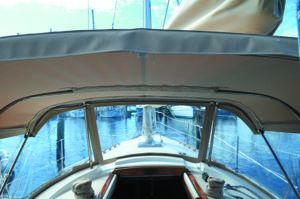
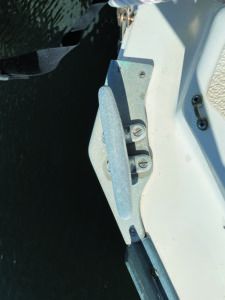
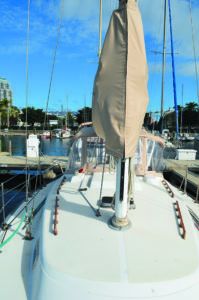
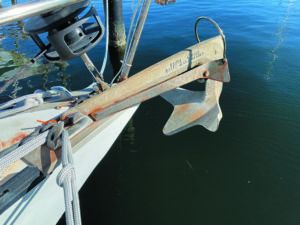
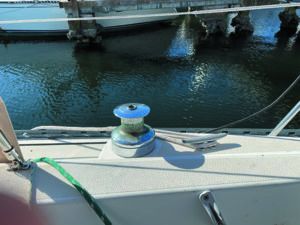

One advantage of the fractionally-rigged boat’s large mainsail—it’s just over 300 square feet, about what you’d find on most masthead-rigged 37-footers—is that the boat balances and sails reasonably well under mainsail alone. This is a useful feature for shorthanded cruising, when you may find yourself circling a harbor under sail looking for a place to anchor. With the Tartan 33, you can drop the jib and clear the foredeck for anchoring while still maintaining good sailing ability under mainsail.
Shrouds are set well inboard, and you’ll almost always find inboard genoa tracks just outboard of the cabin trunk, even though it was an option.
Wheel steering was standard on the boat, and the 32-inch wheel provides plenty of power as well as good feedback. The rudder is partially protected by a vestigial skeg, and is a deep, high-aspect-ratio appendage— practically parallel-sided in profile— rather than the more efficient elliptical shape seen in more modern racing boats and performance cruisers.

2. The steering gear is accessible through the cockpit seat locker. Inspect the stern tube for cracks from a hard grounding.
3. The rugged chainplates should be inspected for signs of corrosion, especially where they pass through the deck.
Most of the new boat owners who completed our first survey praised the Tartan 33 for its practical features.
A Lively Ride
The boat is tender, lively, solid, and fun to sail. We got oversize self-tailing winches, and the longer we own the boat, the more convinced we are of this choice. The fractional rig and good cockpit layout allow my wife and me to handle the boat in safety and comfort in high winds and heavy seas. The Scheel keel offers shallow draft with good stability, but performance is a little poor close hauled in slop and light air.
J.D. Cowan
Columbus, OH
1980 model
Downwind scooter
With a fractional rig and Scheel keel, she cannot point as well as comparable masthead boats, but the large main gives an off-wind advantage. Since Tartan came out with the 33R with masthead rig and fin keel, I assume that the upwind performance of my boat did not appeal to some racers.
The lower lifelines interfered with the winch handles on the original Lewmar 40s. I eventually put on Lewmar 44 self-tailers, which are taller and allow the handles to swing between the lifelines.
Construction is excellent for a production boat The interior is not as plush as some cruising boats, but it is very utilitarian. For a cruising boat with good racing potential, my boat is fine. It’s my aim to make the boat I have more competitive, not to look for greener pastures with another boat.
D.N. Pevos
W. Bloomfield, MI
1980 model
Key Additions
I added a propane stove, larger winches, electric refrigeration, an electric anchor windlass, and larger batteries. I also led the halyards back to the cockpit. I bought the boat for ease of singlehanding (I’m a 5’ tall, lightweight female). I live aboard for much of the summer. The interior is a palace for one, fine for two, a bit tight for three, but in a pinch, okay for four.
R.E. Cathou
Lexington, MA
1980 model
Well built
The boat is strong and extremely seaworthy. Poor upwind performance is my greatest frustration. The huge main means that I must reef early. The boat is perfectly balanced with a working jib and a full main, but this isn’t exactly optimum for racing. Warranty claims included minor flaws in the gelcoat, which Tartan repaired shortly after delivery. A great designer (S&S) and a good builder equal strength and quality.
B. Weiss
Stamford, CT
1981 model

Cockpit layout is efficient for sailing, but is somewhat better for cruising than for racing. A mainsheet traveler spans the cockpit well, just forward of the wheel, and genoa sheet winches are outboard of the main coamings, just forward of the traveler. For racing, it would be better to have the genoa winches further forward, so that trimmers would be well clear of the helmsman, and their weight would be further forward. For single-handed or shorthanded cruising, however, the location is almost ideal.
Unfortunately, self-tailing winches were not standard equipment. The stock Lewmar 40s are about the right size for the fractional foretriangle, but would be a little small on a masthead rig with a 150% genoa. Sparkman & Stephens is one firm that can always be counted on to design in a molded dodger breakwater, and Tartan has faithfully put them on their cruiser/racers over the years. Other builders should take note of the simple, functional breakwater on the Tartan 33, which has openings molded in to allow halyards to be led aft if you want to set the boat up for singlehanding.
Construction
Tartan has always had the reputation of being one of the country’s higher-quality production builders, and they deserve it. In general, owners report very few construction shortcomings, and very few warranty claims.
Four owners in our survey had gelcoat blistering problems. That does not constitute an unusually large percentage, but interestingly, the boats reported as having blisters were two pairs that were sequential in the production series. That may be a coincidence, but it’s an unusual one.
Balsa coring is used in both the hull and deck of the Tartan 33. If you replace or move any deck or hull fittings, be sure to seal any exposed balsa with epoxy resin before installing new hardware.
The hull-to-deck joint is made with a standard inward-turning hull flange, overlapped by the deck molding, which is bolted to the hull through an anodized aluminum toerail. The joint is bedded with both butyl and polysulfide. Builders like to use butyl as a bedding compound, since it’s cleaner to use than most gunned compounds such as polysulfide or polyurethane. Butyl has no adhesive properties, however, and in our experience it can be squeezed out of a joint over time if you continue to tighten down bolts to cure a leak. Since only one owner in our survey reported any deck leaks, Tartan’s combination seems to work well.
Several owners complain about the lack of a top-loading anchor well. Wells can be a nuisance when racing, since they frequently hold a fair amount of water. For coast-hopping, however, an top-loading well in the lets you easily clear the foredeck of gear.
There is an absolute minimum of exterior wood on the Tartan 33: handrails atop the cabin, trim around the companionway. The boat is much more austere than you think of when Tartan comes to mind, but the racing Tartans have always been pretty basic.
Two-tone decks were an option, although the standard monotone deck was available either in white or a light buff. With the two-tone deck package, non-skid areas on the deck, coaming tops, cockpit seats and deckhouse were a nice buff color, contrasting with the stark white of the rest of the deck molding. If you buy a monotone boat, the areas could be painted a contrasting color. A white Tartan 33 with white monotone decks is a plain vanilla boat, indeed.
You’ll find a three-cylinder, 24-hp Universal diesel in every Tartan 33. Owners report that the engine has been smooth-running and reliable, and that it’s adequate power for the boat. An aluminum fuel tank holds 26 gallons, giving a range of about 200 miles under power.
All in all, there’s little to quibble with in the design and construction of the Tartan 33: it’s simple, straightforward, and well executed.
Interior
The interior layout of the Tartan 33 has both fans and detractors. The head configuration, for example, is something you either love or hate. To give more room, particularly for showering, the head compartment runs the full width of the boat. A bi-fold door shuts off the head from the forward cabin, and another bi-fold door closes the head to the main cabin. Two opening ports provide ventilation in fair weather.
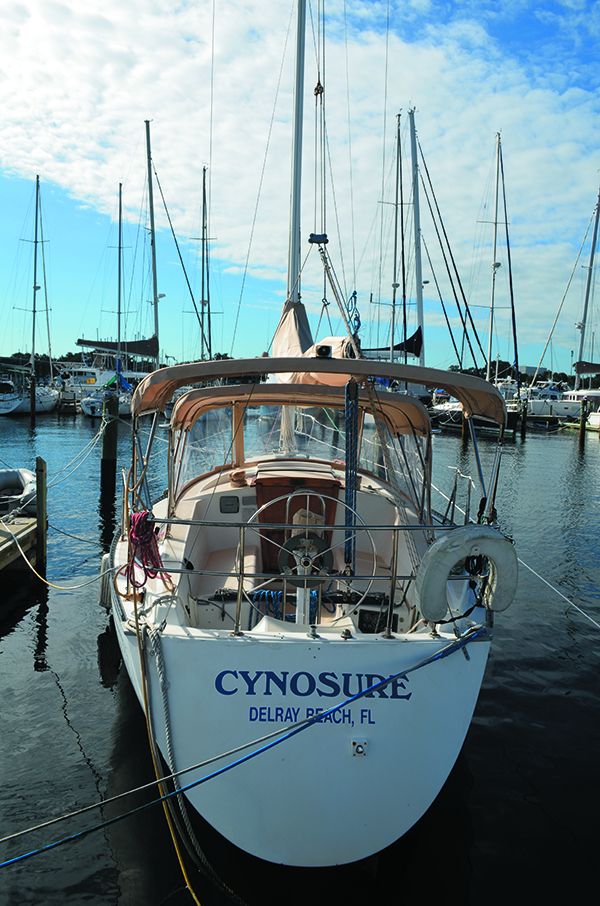
The difficulty with this arrangement is that you cannot get either into or out of the forward cabin if someone is using the head. This wouldn’t be a problem for cruising with a couple, but it could be a nuisance with a lot of people aboard. Closing the door to the forward cabin also cuts off ventilation forward, unless the weather is good enough to have the foredeck hatch open.
The problem is made even worse when the insert is used in the V-berth to form a double. This completely eliminates any standing room in the cabin, so that you climb into the berth directly from the head compartment.
It works, but there’s a fair amount of psychological resistance to the arrangement, since it is one usually seen on smaller boats.
Ironically, the full-width head is a really good one, with plenty of elbow room for showering and dressing. Even without the berth insert in place, standing room in the forward cabin is marginal, and headroom is very limited.
While the forward berths are quite long, they are extremely narrow at the foot, so that two tall people will be tangling feet if they use the berths as two singles. As a double, sleeping parallel to the centerline, this is less of a problem.
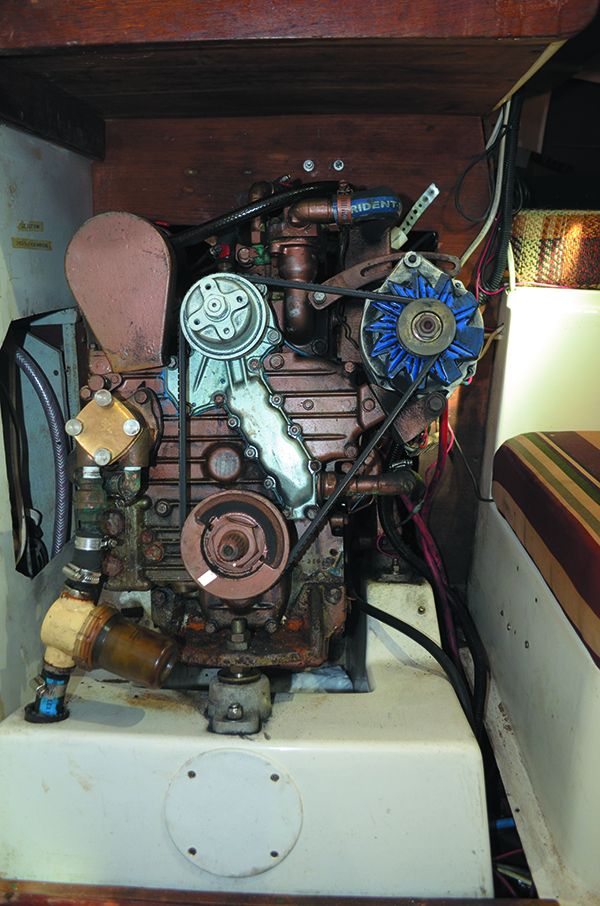
My 1980 Tartan 33 Cynosure still turns heads. But like any piece of machinery, the Tartan 33 needs to be maintained. For someone looking at a used Tartan 33, or other Tartan from that era, here are some areas of concern.
- Chain plate area – Tartan chain plates are a flat slab of stainless steel that passes through the deck and mounts to the mid-ship bulkhead. The through-deck area includes an escutcheon plate. Part of normal maintenance is renewing the chalking/waterproofing in this area. Throughdeck leaks usually first show as discoloration on the chain plate. Leaks can lead to bulkhead damages as well.
- Genoa tracks – As these boats age, the waterproofing on the Genoa tracks needs renewing. The good news is that the port side is super easy. Remove a piece of molding over the pilot berth, and with some help from someone topside you can loosen the fasteners. The starboard side is not so easy. To access the nuts under the Genoa track requires removing the top of the cabinets and one of the partitions.
- Portlights – At this point in their life cycle the Beckson ports are likely to leak, which stains or harms the interior teak. It is possible to replace the lenses and renew (clean) the rubber gaskets, but purchasing new Beckson ports is often the best option.
- Engine – The Universal 5424 /Kubota engine is a classic old-school diesel. Be sure to show the engine you care- change the oil, give her clean fuel and keep her cool, and she will run fine. At this point in the engine’s life consider replacing the glow plugs and replacing or rebuilding the injectors.
- Starboard drinking water tank- These tanks are famous for leaking. I finally decided to place a collapsible tank inside my existing tank.
Room for improvement
- Sails – The best way to both enhance your ride and be the envy of sailors with newer production boats is to put a good set of sails on her.
- Jib shaping – the T-33 is a roller furling fractional rig with the ability to point fairly well. The compromise to this design is that keeping the correct jib sheet angle (vertical and inboard/outboard) is a challenge. The reward for good sail quality and good sheet angle is a peppy old boat (think 60% TWS). So how do you get your jib angle right?
1) Purchase Garhauer adjustable cars. This relatively inexpensive upgrade allows you to easily open and close the leech regardless of reef.
2) Purchase 2-3 snatch blocks. When the AWA is 80 degrees or higher, the jib develops a hook. This is where the slotted toe rail comes in handy (aside from not needing varnish). Take the jib sheet through a snatch block mounted at the boarding gate and then through the genoa car (pulled fully aft), which creates an effective jib shape.
- Jib size – When I purchased my boat she had a 135 and a 150 that was a thin light-air sail. I found the 150 to be simply too much sail in winds above 10 knots. When it came time to replace my jib, I purchased a 135%, 8.1-oz., tri-radial jib. Soon after, she had a matching 8.1-oz. tri-radial main (see cover photo).
- Main sail trim – The relatively large main sail requires attention. The T-33 likes to sail more upright so be ready to ease the main (under-trim) in the gusts.
- Ice box – Most of these boats have been retrofitted with refrigeration. Consider adding 1” of pink foam to make the ice box more efficient.
- Cabin overhead – when replacing the wood and fabric in my overhead I placed ½-inch insulation and added recessed lighting. Replacing the wood and fabric eliminated the old-boat-smell. Adding recessed lighting with switches by the companionway made the cabin much brighter.
- Countertops – The paucity of veneer, means dings to the wood can be oiled to darken, which then become part of the boat’s patina. The exception is its Formica countertops, which will yellow with age. With some basic wood working skills, the Formica can be easily replaced.
Practical Sailor boat reviewer and products and electronics tester Capt. William Herrmann is a delivery skipper based in St. Petersburg, Florida. His website is www.uscgcaptain.com.

The main cabin layout is also unusual. To starboard, there is a fairly standard settee that extends to form a reasonably-sized double, with a shelf outboard. A dining table folds up against the starboard forward bulkhead.
On the port side, the arrangement is less standard. Instead of a normal settee berth, there is a short settee—less than 5-feet long—with the icebox occupying a high counter at what would normally be the head of the berth. This short settee could function as a berth for a child, but obviously not for an adult. Outboard of the settee, there is a narrow pilot berth, which is comfortable and secure, and fortunately isn’t jammed as high under the side decks as they frequently are.
Main cabin ventilation is provided by six opening ports, two cowl vents in dorade boxes, and an aluminum-framed centerline hatch, which was an option, but a common one.
The galley—aft on the starboard side—is not the most efficient in the world, since you have to turn around and step across the main cabin to reach the icebox. In addition, the icebox top is the only usable food preparation counter space, which puts the cook in the middle of the main cabin traffic flow.
A two-burner alcohol stove was standard equipment, but a large percentage of boats have the optional three-burner gimbaled alcohol stove with oven. A deep single sink is just aft of the stove, but it’s a bit of a reach to use, since the flat of the cabin sole doesn’t extend very far outboard in this part of the hull.
Aft of the icebox is a sit-down chart table. The working surface is a reasonable size, and the outboard locker could be sacrificed for the installation of electronics.
While there is a contoured, upholstered seat for the nav station, it does not exactly face the chart table, and it is offset from the center of the table. The navigator has to make a bit of a stretch to reach the outboard part of the table, or to use any electronics that might be mounted outboard.

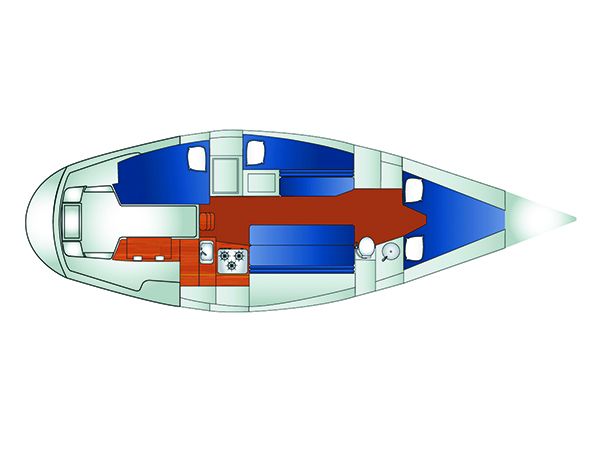
Tartan 33 in Context
| TARTAN 33 | C&C 34 | SABRE 34 | CATALINA 34 MK I | |
|---|---|---|---|---|
| LOA | 33’ 8” | 33’ 6” | 34’ 2” | 38’ |
| LWL | 28’ 10” | 25’ 11” | 26’ 3” | 29’ 10” |
| BEAM | 10’ 11” | 11’ | 10’ 6” | 11’ 9” |
| DRAFT (SHOAL) | 4’ 6” | 5’11” (4’) | 5’ 6” (3’11”) | 5’ 7” (3’10”) |
| DISPLACEMENT | 10,000 lbs. | 10,100 lbs. | 11,400 lbs. | 11,950 lbs. |
| BALLAST | 4,400 lbs. | 4,100 lbs. | 4,600 lbs. | 5,000 lbs. |
| SAIL AREA (SPEC) | 531 sq. ft. | 517 sq. ft. | 506 sq. ft. | 523 sq. ft. |
| ENGINE | 24 hp. | 30 hp. | 30 hp. | 25 hp. |
| WATER TANK | 60 gal. | 60 gal. | 44 gal. | 70 gal. |
| FUEL TANK | 26 gal. | 40 gal. | 20 gal. | 23 gal. |
| SA/D | 18.4 | 17.7 | 16 | 16 |
| D/L | 186 | 259 | 281 | 200 |
| PRICE * | $25,000- $40,000 | $20,000- $30,000 | $25,000 - $40,000 | $20,000 - $40,000 |
Aft of the nav station is a big double quarterberth. A drop-in insert which covers the nav station seat forms the head of the inboard portion of the quarterberth, although the berth can be used as a single without disturbing the navigator. This is basically the same quarterberth layout used in the Tartan 37. Awkward on the 37, it’s a bit more acceptable on a smaller boat where space is at even more of a premium.
Most owners who have lived with the interior for some time find it quite workable. A top Tartan dealer told us, however, that he has definitely seen buyer resistance to it. Certainly the redesigned interior of the Tartan 34 is substantially better.
Conclusions
If you’re looking for a fairly fast, high-quality, late model cruiser/racer, with a great owner support group, the Tartan 33 is a good choice. In general, prices will be very comparable to those of other quality boats of the same size and vintage, such as the C&C 34 and Sabre 34. Performance of these three boats is also similar.
TARTAN, www.tartanyachts.com TARTAN OWNERS NORTHEAST, https://tone.clubexpress.com/


































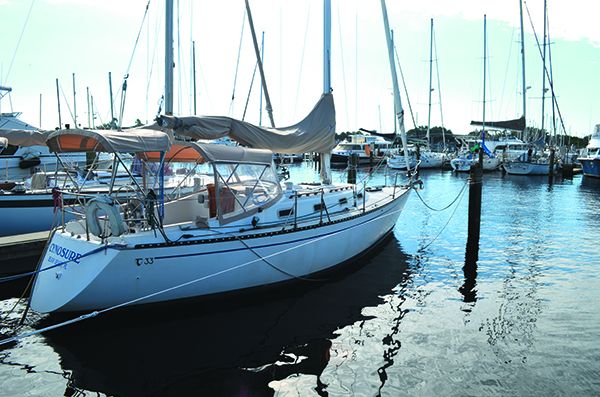





Thank you for the well researched and informative review with comparisons for Tartan 33. Especially good consideration of sails and adjustments.